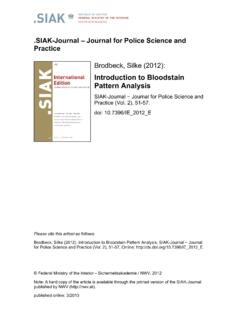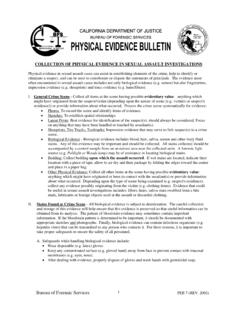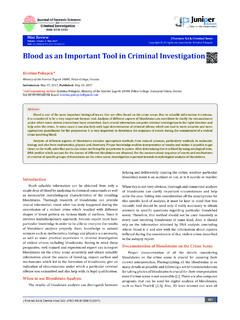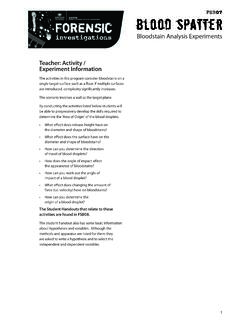Transcription of The Impact of Forensic Science Research and Development
1 Department of JusticeOffice of Justice ProgramsNational Institute of JusticeNATIONAL INSTITUTE OF JUSTICETHE Impact OF Forensic Science Research AND DEVELOPMENTAPRIL Department of Justice Office of Justice Programs810 Seventh St. Washington, DC 20531 Eric H. Holder, Jr. Attorney GeneralKarol V. Mason Assistant Attorney GeneralNancy Rodriguez, Director, National Institute of JusticeThis and other publications and products of the National Institute of Justice can be found at:National Institute of Justice Strengthen Science Advance Justice of Justice Programs Innovation Partnerships Safer Neighborhoods National Institute of Justice is the Research , Development and evaluation agency of the Department of Justice. NIJ s mission is to advance scientific Research , Development and evaluation to enhance the administration of justice and public is a component of the Office of Justice Programs, which also includes the Bureau of Justice Assistance; the Bureau of Justice Statistics; the Office for Victims of Crime; the Office of Juvenile Justice and Delinquency Prevention; and the Office of Sex Offender Sentencing, Monitoring, Apprehending, Registering, and Tracking (SMART).
2 Opinions or points of view expressed in this document are those of the authors and do not reflect the official position of the Department of Justice. Photo Source: ThinkStockAPRIL 2015 NATIONAL INSTITUTE OF JUSTICENIJ SCIENTIFIC STAFF: GREGORY DUTTON, DANIELLE McLEOD-HENNING, MINH NGUYEN AND FRANCES SCOTTBOOZ ALLEN HAMILTON SUPPORT STAFF: VANESSA CASTELLANOS, ANASTASIA DUPONT AND CHAD ERNSTNCJ 248572 The Impact of Forensic Science Research and Development 3 National Institute of Justice | Impact OF Forensic Science Research AND DEVELOPMENTIn crime labs across the United States, scientists and technicians are being armed with increasingly sophisticated technologies that they can use to help bring criminals to justice and prevent the innocent from going to prison. Innovations from Forensic Science Research and Development (R&D) are bringing new techniques to crime solving and increasing the reliability and efficiency of Forensic as medical Research is crucial for advancing public health, sustained progress in the Research underlying Forensic Science is critical for advancing public safety and the administration of Science to improve justice is a key goal of the National Institute of Justice (NIJ).
3 Toward that goal, NIJ funds both basic and applied Forensic addition, NIJ maintains partnerships with the National Science Foundation (NSF) and the National Institute of Standards and Technology (NIST) to promote innovation in Forensic Science . In 2014, NIJ and NSF jointly initiated an Industry/University Cooperative Research Center to advance university and industry collaboration in Forensic Science R&D and in of several NIJ-NIST working groups has developed best practices for the handling and preservation of DNA and other biological evidence. Other working groups in the partnership are addressing the interoperability of regional and national automated fingerprint identification systems (AFIS); developing procedures to limit investigator bias in examining fingerprints; and creating examination standards for a variety of evidence types in criminal 2009, the Institute has invested more than $127 million in an R&D portfolio that makes it a global leader in the advancement of Forensic The Impact of Forensic Science Research and DevelopmentNational Institute of Justice | Crime LaboratoriesForensic Science R&D in the 1980s laid the groundwork for advances in the 1990s and early 2000s that had a profound Impact on crime laboratories.
4 Although the scientific advances, particularly the growth of DNA testing, provided more effective tools for analyzing evidence and identifying perpetrators, they also led to a dramatic increase in the demand for lab services. By the late 1990s and through the 2000s, demand outstripped the ability of the labs to respond quickly and efficiently. Today, scientists and technicians at Forensic labs are under relentless pressure to produce results faster and at lower cost. NIJ employs a two-pronged approach to supporting Forensic labs: In the short term, NIJ awards grants to labs that cover the increasing costs of processing cases, assist in DNA backlog reduction and support ongoing efforts to adopt more advanced instrumentation and analytical methods. In the long term, NIJ awards grants to scientists to conduct Research , both basic and applied, that can lead to methods, techniques and technology that will advance Forensic Science and, ultimately, public safety and is an essential way to assist crime labs.
5 For example, high-tech robotic workstations can now process large numbers of DNA samples simultaneously, allowing crime labs to work more efficiently. NIJ-supported Research helped in the Development of fully automated systems that amplify DNA from small samples to determine a person s genetic profile. The workstations not only make labs more efficient but also lower the cost of DNA is also funding several projects that seek to apply more sophisticated methods to detect and analyze evidence. Examining evidence for trace amounts of blood or other biological material is time consuming for law enforcement and crime lab personnel, and it requires techniques that can compromise or destroy evidence. One NIJ-funded project involves developing a camera with multispectral and fluorescence imaging capabilities to detect and identify fingerprints, body fluids, stains and other residues at crime scenes.
6 Such imaging technology would make it easier for investigators to find and process evidence while minimizing evidence working on another NIJ-supported project are developing methods that will allow investigators to identify the body fluids in a stain without destroying any of the stained material. Researchers are also exploring how to use one sample to determine multiple pieces of information, such as body fluid type and genetic information associated with Impact of Forensic Science Research and Development 5 National Institute of Justice | Forensic Technology in the FieldLaw enforcement investigators, as well as scientists and technicians in crime labs, must rely on new technologies and scientific innovations to more efficiently identify, gather and process evidence related to criminal activity. The NIJ portfolio covers a wide range of Forensic Science disciplines, both for investigators in the field and for scientists in the Drugs in the FieldResearchers working on a current NIJ-supported project are developing a simple yet sophisticated device that may soon allow law enforcement personnel to quickly identify illegal drugs using a handheld fluorometer and a smartphone.
7 The fluorometer, constructed for about $45 with a 3-D printer, allows investigators to identify powders and other substances using a paper test strip soaked in copper iodide. Certain classes of drugs react with the copper by giving off a fluorescent light signature unique to the drug. An investigator in the field can photograph the fluorescence spectrum with a smartphone, upload the results to the Cloud, compare it to known spectra in an online database for identification, and use that information in building a criminal case. According to the lead researcher, the system requires only a small amount of the drug for testing and has not shown false positive the Accuracy of Firearm ExaminersSince 2009, NIJ has supported studies to determine the accuracy and reliability of firearm and toolmark examinations. In a recent collaboration between the Miami-Dade Police Department and researchers at Florida International University, scientists tested the accuracy of firearms examiners analysis of researchers found that firearms examiners had an average error rate of less than percent.
8 The experiment used bullets fired from 10 consecutively manufactured Glock barrels with the same EBIS (Enhanced Bullet Identification System an etched-barrel barcode system) pattern. These comparisons, which used bullets fired from barrels intentionally made as similar as possible, were designed to be among the most challenging that an examiner could face. The Research team distributed 150 test sets to 165 firearms examiners in 41 states, the District of Columbia and four other countries. A test set consisted of one known bullet test-fired from each barrel, plus 10 unidentified bullets drawn from the test fires. This was the largest sample size ever used for this type of experiment. Most examiners recorded no incorrect answers, and the average examiner rate was less than percent. The researchers found no significant difference in error rates between examiners with more than 10 years of experience and those with less The Impact of Forensic Science Research and DevelopmentNational Institute of Justice | growing demands for evidence processing in recent years have clearly shown that labs must move to more efficient and sophisticated methods and procedures.
9 Scientific and technological advances made possible through strong support for Research will be essential to ensuring that crime labs keep pace with increasing Law EnforcementScientific advances already play an important role in solving crimes. Labs can analyze smaller pieces of evidence than ever before, and law enforcement officials can gain valuable information from evidence that, in the past, would have been degraded and unusable due to weathering or time. New technology also allows investigators to find and analyze evidence that they would likely not have found via earlier methods. One example of this increasingly sophisticated technology is a method that could help Forensic scientists analyze dust and other particles that piggyback on carpet fibers to determine whether fibers found in different locations are consistent with having originated from the same source.
10 In some instances, such a comparison could provide investigative leads associating a suspect or victim with a crime can now use DNA and other evidence collected and stored decades ago to help identify and convict criminals who have eluded authorities for years and to exonerate prisoners who were wrongly convicted before today s more sophisticated methods became available. A striking example of new technology solving a cold case occurred in 2009, when Milwaukee police tested evidence in a reopened case and eventually linked nine murder cases dating back to 1986. They identified Walter Ellis as the suspect in what were known as the North Side Strangler cases. Faced with the new evidence, Ellis pleaded no contest to charges that he strangled seven women. In 2011, he was sentenced to seven life terms with no chance of of the more difficult challenges facing police officers working in the field today is accurately identifying substances that may be illegal drugs.
















